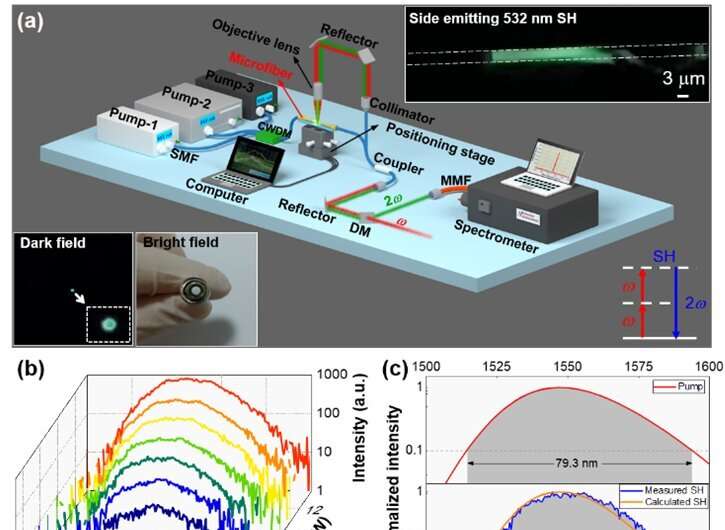Broadband and continuous wave pumped second-harmonic generation from microfiber coated with layered GaSe crystal

Second-order optical nonlinear effects have received widespread attention from researchers since its first discovery in the 1960s.
Based on second-harmonic and sum-frequency effects, the lasers ranging from ultraviolet to far infrared bands have been generated, greatly promoting the development of laser techniques, optical information processing, high-resolution microscopic imaging.
According to nonlinear optics and polarization theory, even-order nonlinear optical effects are strongly determined by the crystals’ centrosymmetry, and the second-order nonlinear susceptibility is nonzero only in non-centrosymmetric medium. However, as the most fundamental second-order nonlinear effect, the centrosymmetry of the silica fiber hinders the generation and utilization of second-harmonics.
The widely employed poling methods (such as optical poling, thermal poling, electric field poling) can artificially break the centrosymmetry of the fiber, effectively improving the second-order nonlinearity of the fiber. However, complex processes and harsh fabrication conditions are required, and quasi-phase-matching conditions can only be satisfied at discrete wavelengths, which limits the operation bandwidth. The optical fiber ring based on whispering gallery mode also greatly limits the wide spectral excitation of second-harmonics.
By breaking the centrosymmetry at the surface of an optical fiber, the surface second-harmonic in the special structure optical fiber can be enhanced to some extent, but the femtosecond pump pulse with very high peak power is still indispensable. Therefore, alternative solutions would hence be welcome to avoid delicate fiber post-processing while still allowing operations over a wide pump wavelength range.
A research group from Northwestern Polytechnical University proposed a scheme of integrating long-range ordered layered gallium selenide crystals into microfibers and achieved the broadband second-harmonic and multi-frequencies conversion. This provides a new solution for the enhancement of multiple parameter processes in the fiber and the development of quasi-monochromatic/broadband light sources. The paper is published in the journal Opto-Electronic Advances.
The efficient excitations of second-harmonic and sum-frequency effects in this scheme mainly depends on the following three key conditions: the long light-matter interaction length between gallium selenide and pump light, high nonlinearity of gallium selenide crystal, and satisfaction of phase matching conditions.
In the experiment, the microfiber prepared by a flame brushing system has a millimeter-level uniform tapered region, providing a sufficiently long nonlinear interaction length. The nonlinear susceptibility of gallium selenide is more than 170 pm/V, which is far greater than that of the pristine fiber, and the long-range ordered structure of the gallium selenide crystal ensures the accumulated constructive interference of the second-harmonic. More importantly, by controlling the diameter of the microfiber in the fabrication and thereby modulating the waveguide dispersion, the phase matching between pump and second-harmonic modes is satisfied.
The above conditions lay the foundation for efficient and broadband excitation of second-harmonics in the microfiber. The experiment results show that under the pumping of 1,550 nm picosecond laser, nanowatt-level second-harmonic was achieved. Second-harmonics can also be efficiently excited under the 1,550 nm continuous wave source, and multi-frequency conversions were observed when three pump wavelengths are employed. Moreover, by replacing the pump with a superluminescent light-emitting diode (SLED) source of 79.3 nm bandwidth, a broad second-harmonic with a bandwidth of 28.3 nm was produced.
In addition, if chemical vapor deposition instead of the dry transfer technology is employed to grow few layers gallium selenide on the microfiber surface over a long length, the second-harmonic conversion efficiency is expected to be further improved.
More information:
Zhen Hao et al, Broadband and continuous wave pumped second-harmonic generation from microfiber coated with layered GaSe crystal, Opto-Electronic Advances (2023). DOI: 10.29026/oea.2023.230012
Provided by
Compuscript Ltd
Citation:
Broadband and continuous wave pumped second-harmonic generation from microfiber coated with layered GaSe crystal (2023, June 26)
retrieved 26 June 2023
from https://phys.org/news/2023-06-broadband-second-harmonic-generation-microfiber-coated.html
This document is subject to copyright. Apart from any fair dealing for the purpose of private study or research, no
part may be reproduced without the written permission. The content is provided for information purposes only.
For all the latest Science News Click Here
For the latest news and updates, follow us on Google News.

